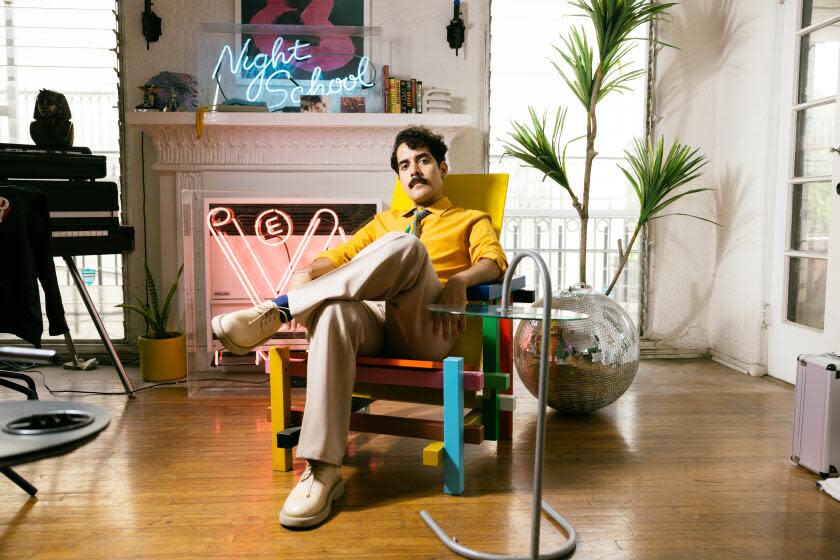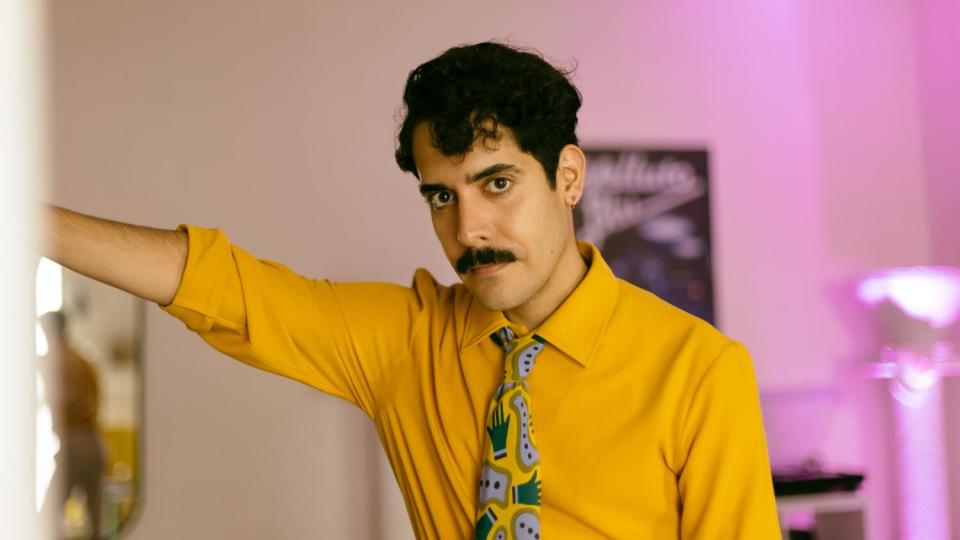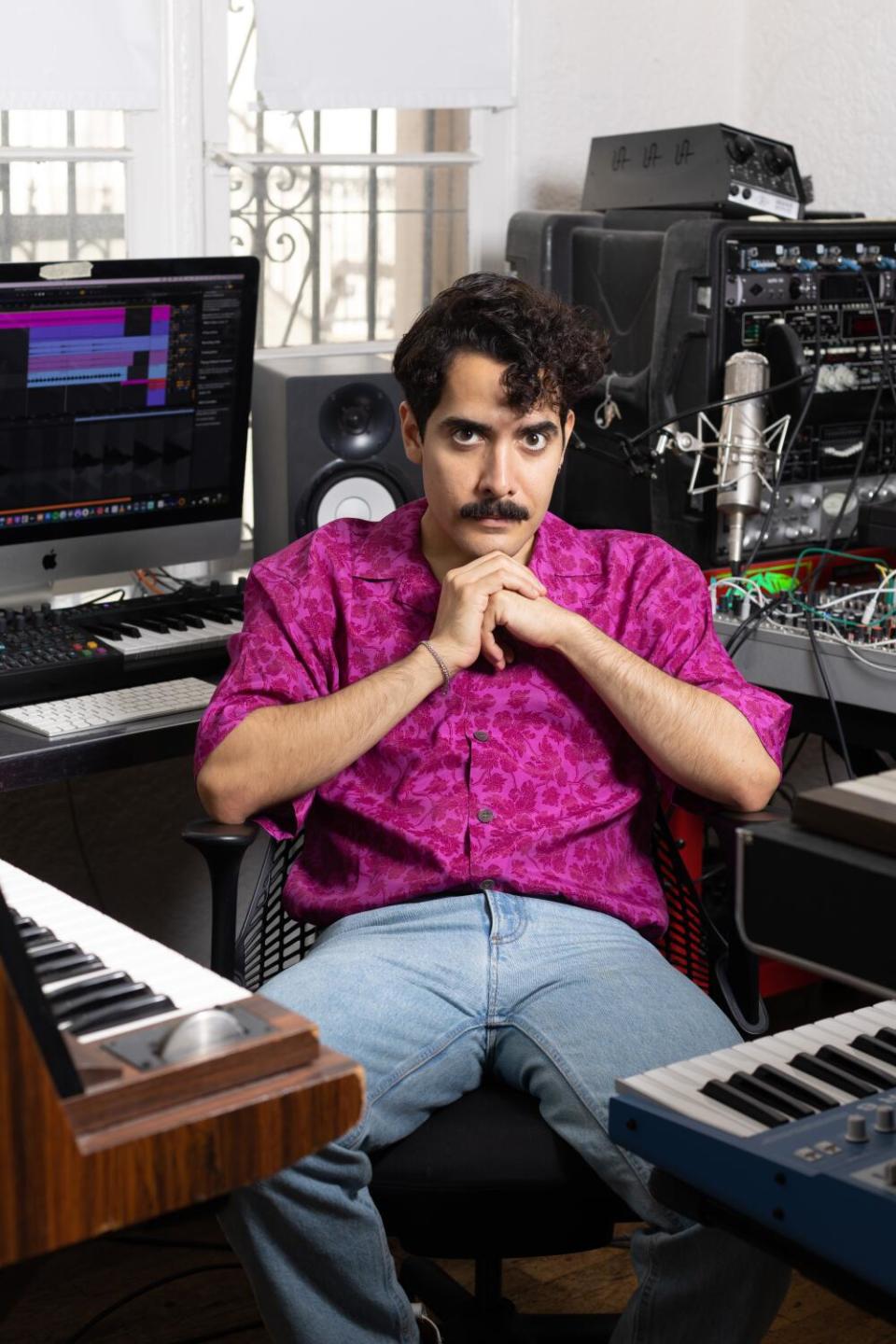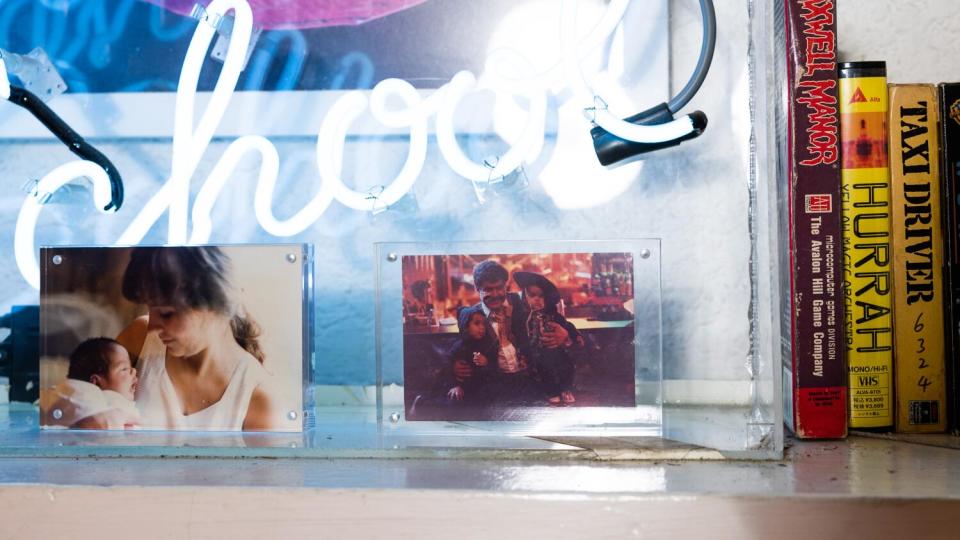Alan Palomo shelves Neon Indian name, mines the 1980s in new album

- Oops!Something went wrong.Please try again later.
Much has changed in the eight years since avant-pop artist and filmmaker Alan Palomo released his last album.
First, he's no longer performing under the name Neon Indian — "I'm going solo from myself," says Palomo, 35. Second, he's jarred by the prospect of promoting his music on TikTok: "I might have to work on some dance challenges," he adds with a laugh. Third, he's noticed his songs crop up on Spotify and Apple Music playlists labeled "Indie sleaze" — which is not a term that anyone used for hipster culture in the 2000s, but has become shorthand for a scene that Palomo lived on the fringes of.
Read more: Why Omar Apollo's coming-out story matters
"It would have been a perfect time to put out a Neon Indian record, with all the nostalgia," says Palomo, who welcomes me into his Highland Park home. Inside, echoes of Brazilian jazz bounce off the stucco walls.
"But by the time I put out my first record, bloghouse was on its way out," he explains. "I missed that wave, dude! I was outside of the party, looking in!"
Palomo began making music as Neon Indian while studying film at the University of North Texas in Denton. Released in 2009, his hypnagogic pop opus "Psychic Chasms" brought splashes of technicolor to the lo-fi psychedelia of chillwave: an electronic micro-genre he pioneered along with American indie acts Washed Out and Toro y Moi. "Psychic Chasms" became the first in a trilogy — followed by the 2011 album "Era Extraña," then 2015's "Vega Intl. Night School" — in which Palomo's elastic vocals, buried for years beneath blankets of reverb and static fuzz, eventually came up for air.
Read more: DannyLux, el romántico for the TikTok generation
It was in 2019 that Palomo released "Toyota Man" — his first song in Spanish — which lambasted U.S. border policy, while also detailing his family's immigration from his birthplace of Monterrey, Mexico, to San Antonio, Texas. It was a rare glimmer of righteous anger in the artist's oeuvre, which seemed better suited for parties than protests; since then, he's explored the Spanish language not just as a speaker, but as a songwriter. "I thought about Luis Miguel importing funk to Mexico," he says. "And I thought, what if I approached it like that?"

Released on Sept. 15, his new album, "World of Hassle," is a glittering, global ethnography of 1980s pop. His bubbly manipulations of Italo disco, synthwave and Japanese city pop evoke an era he lived in vicariously through his expansive vinyl collection — not to mention his dad, Mexican singer Jorge Palomo. Tales of island getaways and cutthroat club girls are told from the viewpoint of a fictional aging pop star, whom Palomo plays in English, Spanish and, for a spell, even French.
Armed with an arsenal of vintage keyboards and Moog synthesizers, Palomo and his band are gearing up for his “World of Hassle” U.S. tour, which includes a stop in Los Angeles' El Rey Theater on Oct. 21. "I don't care if it sounds new, or old, or whatever," he says of the album. "What you hear is me trying to buy happiness on Discogs during the pandemic!"
This interview has been condensed and edited for clarity.

Here's a burning question. Why ditch the name Neon Indian?
It's such a tried-and-true ’80s male rock cliché to like leave your band in your mid-30s and make a jazz record — which is the idea I was playing with. Bryan Ferry is the king of that. He [found] a perfect formula in "Avalon" [with Roxy Music] — then made three more of those just under his own name. And as somebody that has aspirations beyond music — not just being that guy who made “Deadbeat Summer” — shedding the moniker and being Alan Palomo made sense to me.
What’s your life been like since you released your last record?
I toured ["Vega Intl. Night School"] for three years or so. I started dating somebody out here, so I moved [to Los Angeles], but then COVID hit. I bought myself a piano, taught myself how to sight-read, which is how I started this album. But the last time I released a record, I didn't realize how little control that artists and even labels would have in deciding what the big single is. It’s very much on streaming platforms’ terms. When putting out a record, you feel like a chip on a virtual craps table that these robots are gambling with. It's insane. And now with TikTok? I might have to work on some dance challenges.
But as a filmmaker, your skills might translate well on TikTok! What did you watch while working on "World of Hassle?"
I was recording my vocals at a house rented out by my friend Dan [Lopatin], who goes by Oneohtrix Point Never. We watched this documentary called “Bring On the Night.” It's all about Sting going solo. He [sent] members of the Miles Davis Band and Weather Report to a 17th century chateau outside of Paris just to rehearse. I love the drama of it all, of him having to prove himself with one record. So ["World of Hassle"] alludes to a fake career as a solo artist who's been around for decades. I even wrote a panned review of my own album for the artwork!
"World of Hassle" is this time capsule chock-full of 1980s vibes, like a sampler of easy-listening radio from different places. How did you develop this well-traveled sound?
It can be a bit of a smorgasbord, but that's the DJ in me. I see it as ethnomusicology. People say, "Why are you so stuck in the ’80s?" But once you think you've discovered everything about disco, R&B or jazz in this country, then you realize a whole other thing was happening in like, Brazil. I found my way to Robson Jorge and Lincoln Olivetti, Marcos Valle, Rita Lee. I went down that rabbit hole to see what I can come back with.

Your dad, Jorge Palomo, was a pop singer in the 1980s. How did your parents influence your music?
My parents were fresas, you know? My dad was a singer and my mom produced a local TV show in Mexico. They listened to stuff like Gloria Trevi [and] Luis Miguel. My dad is a die-hard Beatles fan too — that’s how I learned like, a formalist pop song structure. My dad made me and my brother, Jorge Jr., sing duets and perform Timon and Pumbaa scenes from “The Lion King” for relatives. I was more into movies, while my brother got into jazz and went to Berklee [College of Music]. Now he plays [bass] in my band.
What was it like, coming to the U.S.?
I think it was the year that “The Lion King” came out. I had packed all these toys, but it didn’t register to me that we were moving. I thought we were just visiting. When we moved to the States, everybody had to pull themselves back up. My dad got work [singing] at nightclubs, but my mom had to scrub toilets until she got a job at the Mexican Consulate. It was a privileged position for us, because it helped streamline our citizenship. Then she worked at a radio station, and eventually Telemundo. I would hang out at work with her and [admire] all the cameras and recording equipment.
Your 2019 song, “Toyota Man,” was not just your first song in Spanish — it marked this major turning point where you explicitly addressed racism and xenophobia against Mexican people. What inspired you to take a political stance in your music?
I called my brother, right before I shot a short film ["86'd"] at Frankel's Deli in [Brooklyn]. Trump had just won [the 2016 presidential election], and New York was very bleak that day. It was eating away at me — the feeling that the same system that allowed us to make right with the law and become citizens. He’s gonna keep two kids like us from having the same opportunity.
How did the song come together?
I started by doing a riff on this Los Tigres Del Norte song, "América," where they jokingly use a similar melody to “La Bamba.” The lyrics are like, “If a man born in Europe is European, then how am I not an American?” But because I can't express things without some degree of humor, I interpolated Jimi Hendrix’s cover of the national anthem with “La Cucaracha.” My brother and I joked about calling it Neon Indian's "The Wall." We started filming at the border — we did a "Subterranean Homesick Blues" thing where I held up the lyrics of the song, overlooking the Mexican side. But then the security guys caught on, so we got our permiso [to cross] and got the f— out of there.
What moved you to start releasing more music in Spanish?
I wanted to make a psychedelic chicha and cumbia record. I hadn't written music in Spanish up until “Toyota Man,” which was easy to write because it was biographical. But it was while in the studio with a chilango that I started to doubt myself lyrically, because my Spanish felt so utilitarian. I immersed myself in the language by reading Mexican literature, like Fernanda Melchor and Rudy Herrera, who's more Tejano. I thought, if I broadened the palette of what I [could] sing about in Spanish, then I could express myself more fully.
So what happened to the cumbia project?
Emulating [cumbia] music was difficult for me. My brother grew up playing in cumbia bands in San Antonio. I was around it growing up — remember that song,“El Pi Piri Pau”? I wanted to do goofball stuff like that, but never learned how to write that kind of music. You can’t fake the funk, you know? So I dropped it, I went on this ill-advised tour, and I lost the thread. I will eventually go back and finish it.
In your single, “Nudista Mundial ’89,” you brought in Canadian indie star, Mac DeMarco. How did you guys start working together?
I spent a week in his studio. I was looking for a Yamaha CP-70, which is a portable upright piano that people would take on tour back in the day — Billy Joel famously flipped one onstage in Russia — and Mac had one. So I said, "Why don't we do our version of [the Righeira song] 'Vamos a la Playa?'" I brought him these real Jimmy Buffett Parrot Head lyrics, and he rolled with it. That's when you hear him go, “Dos cervezas, por favor.”
That was Mac speaking Spanish?
Oh. yeah. A Canadian gringo and a Mexican guy go to Ibiza ... and the narrative writes itself.
I think about you and Toro y Moi — Chaz Bear being Black and Filipino — as architects of the millennial chillwave sound. But you were anomalies in a white-dominated indie scene. Did you ever feel like you had to play down your heritage to fit in?
My mom used to say to people, “You just don't like us because we're Hispanic!” My brother and I got really self-conscious about that. Now as an adult, I think, “They probably were being racist!” But there was a naïveté on my part then, which engendered me to just make music and not think about it. In Texas, obviously, I was around a lot of other Mexicans and Chicanos. But in New York, I'd be like, “Whoa — everyone at this party is white! Oh, man — I might be the first Mexican that this website’s written about!” But you know, a lot of indie music at the time came up in American liberal arts schools. There’s been a generational shift with more immigrant families having and raising their kids here.
Right, there are more of us mixing and mingling now.
It was funny to be a Mexican dude who loves Italo disco, whose favorite band is from Japan, just sampling his dad’s old records in Spanish. When people started talking about cultural appropriation in music, it was tough to talk about [as a] musician, because that's how many genres were invented. Cumbia started after [Germans] brought accordions to South America, then mixed it with Indigenous music. I think of it more as cultural cross-pollination.
How do you navigate the space between being proud and being pigeonholed as a Latino?
I wonder: Do we have to say, “This is good for a brown record?” How about we all be thrown in the same space? I’m glad that it's less of a thing now to be like, “Indie? That's for white people!” It can be anything for anybody. Now let’s see what we make of it. Let’s add to the conversation.
This story originally appeared in Los Angeles Times.

